The Israel Iran conflict explained requires understanding one of the most complex and enduring geopolitical rivalries in the modern Middle East, characterising not a direct war but rather a multifaceted struggle encompassing nuclear concerns, proxy warfare, and competing regional ambitions. This comprehensive analysis examines the historical evolution, current manifestations, and future implications of tensions between these two regional powers, providing essential context for understanding contemporary Middle Eastern dynamics. The conflict has evolved from early cooperation during the Cold War to today’s hostile relationship marked by cyber warfare, proxy confrontations, and nuclear brinkmanship that threatens regional stability and global security.
What makes this conflict particularly urgent in 2025 is how quickly things can spiral from shadow warfare to direct confrontation, as witnessed dramatically in June 2025. For millions of people worldwide, this isn’t just another distant geopolitical dispute—it’s a crisis that directly impacts petrol prices, investment portfolios, and even holiday travel plans. Understanding these dynamics has never been more crucial as the world watches two nuclear-capable regions edge closer to unprecedented escalation.
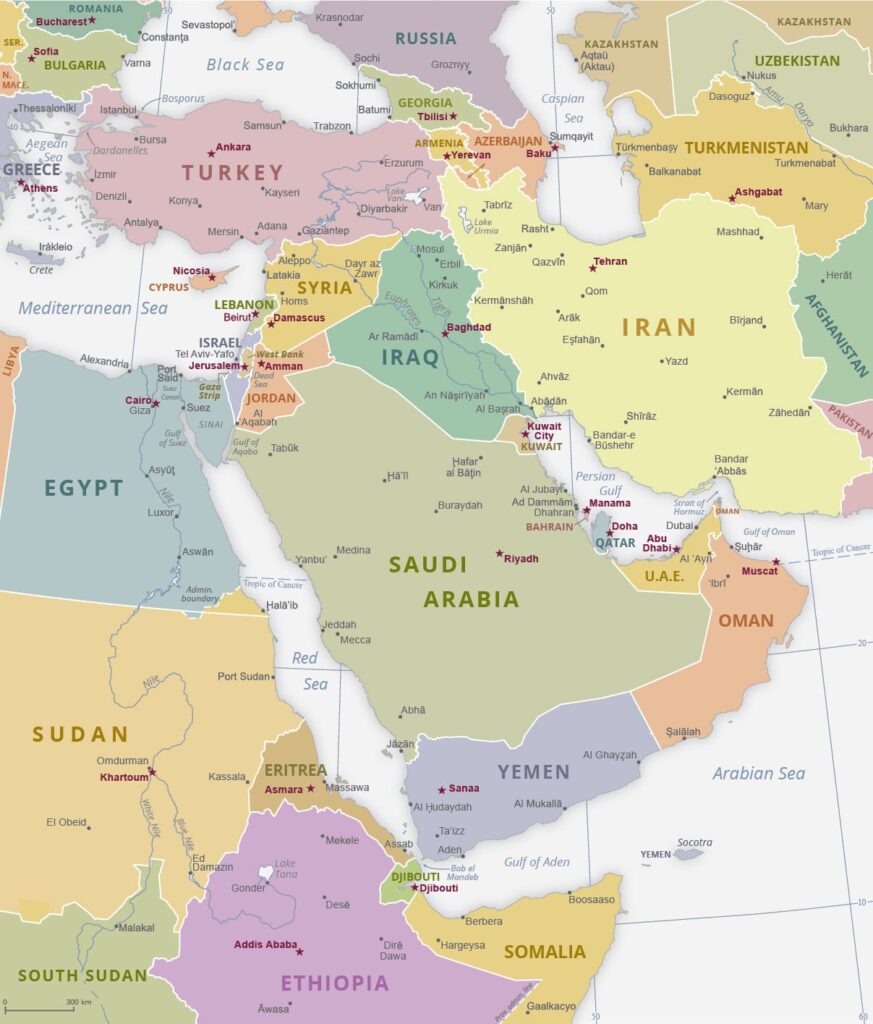
Table of contents
Latest developments (June 2025): a dramatic escalation
The Israel-Iran conflict entered a new and potentially catastrophic phase on June 13, 2025, when Israel launched “Operation Rising Lion,” the largest military assault on Iranian territory since the Iran-Iraq War of the 1980s. This unprecedented escalation has fundamentally altered the regional security landscape and triggered global economic shockwaves that continue to reverberate through international markets.
Operation Rising Lion: Israel’s nuclear gambit
In the early hours of June 13, 2025, Israeli forces executed a coordinated strike targeting Iran’s nuclear infrastructure and military command structure across more than twelve provinces. The operation, involving over 200 Israeli aircraft and sophisticated cyber warfare components, achieved tactical objectives that intelligence analysts had deemed nearly impossible just months earlier. The strikes succeeded in eliminating key figures within Iran’s nuclear programme and military hierarchy, including Islamic Revolutionary Guard Corps Commander Hossein Salami and Chief of Staff of the Armed Forces Mohammad Bagheri.
Perhaps most significantly, the operation killed prominent nuclear scientists Fereydoon Abbasi, former head of Iran’s Atomic Energy Organization, and Mohammad Mehdi Tehranchi, who had been instrumental in Iran’s uranium enrichment capabilities. Israeli Prime Minister Benjamin Netanyahu justified the operation by claiming Iran possessed sufficient highly enriched uranium to produce nine nuclear weapons, stating that Iran “could develop a nuclear weapon in a very short time. It could be a year, it could be within a few months. This represents a clear and present danger to Israel’s existence.”
Iran’s unprecedented retaliation
Iran’s response, designated “Operation True Promise III,” marked the third direct Iranian attack on Israeli territory and the most substantial to date. Tehran launched over 200 ballistic missiles in four coordinated waves, with several penetrating Israel’s Iron Dome defense system and striking civilian areas in Tel Aviv and Jerusalem. The Iranian retaliation resulted in at least 21 injuries in Rishon Lezion, with one person in critical condition, while a high-rise building in Tel Aviv sustained significant damage to its lower floors.
Supreme Leader Ayatollah Ali Khamenei delivered a rare televised address vowing “severe retribution” and warning that Israel would be made “helpless.” Iranian President Masoud Pezeshkian subsequently warned of a “more intense and powerful retaliation” should Israeli attacks continue, whilst Tehran announced its withdrawal from nuclear negotiations with the United States.
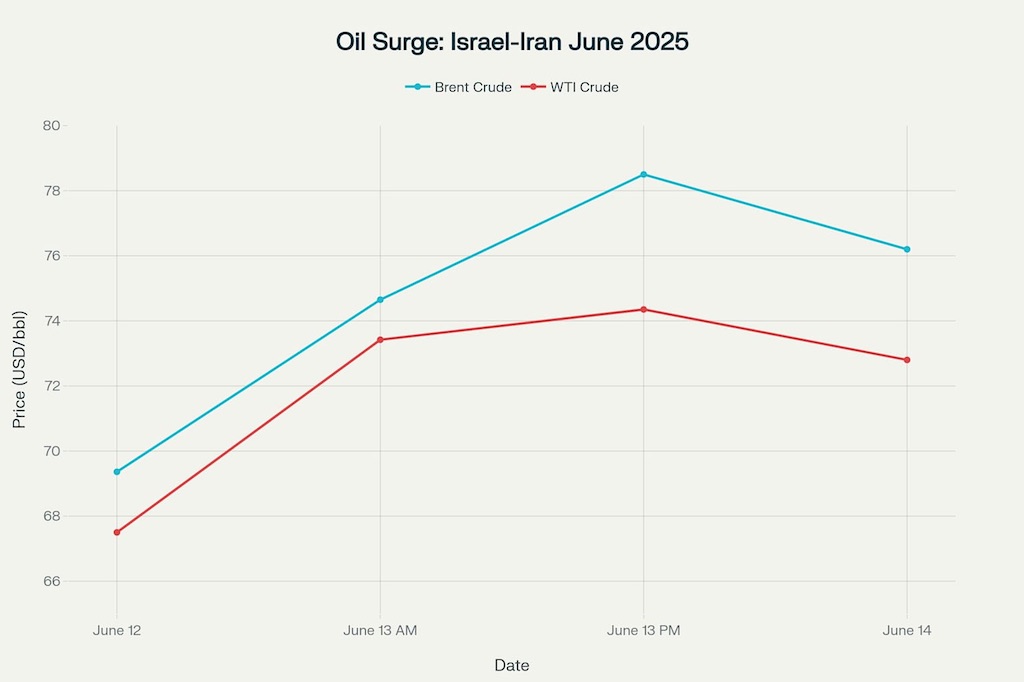
The nuclear timeline: a race against time
The conflict’s most alarming dimension involves Iran’s nuclear capabilities and the narrowing window for diplomatic resolution. Intelligence reports suggest Iran could produce weapons-grade uranium within weeks if it chooses to abandon international agreements entirely. The International Atomic Energy Agency confirmed that Israel’s strikes damaged the Natanz enrichment facility, though it reported no radiation leaks. However, the underground Fordow facility, considered more challenging for Israeli forces to target, reportedly remained operational.
IAEA Director-General Rafael Grossi warned that strikes on nuclear facilities set “a dangerous precedent that could have disastrous consequences.” The timing of the Israeli operation coincided with stalled nuclear negotiations between the United States and Iran. President Donald Trump had warned Iran to accept a new nuclear deal “before there is nothing left,” threatening “even more brutal” attacks if diplomacy failed.
Historical roots and evolution of the relationship
Early relations and strategic partnership (1948-1979)
The history of Israel Iran relations began with unexpected cooperation, as Iran became the second Muslim-majority country to recognise Israel as a sovereign state after Turkey in 1948, despite initially voting against the UN Partition Plan. Following the CIA-backed coup that reinstated Shah Mohammad Reza Pahlavi in 1953, bilateral relations flourished significantly, with both nations viewing Arab nationalist movements as a common threat. Israel’s strategic doctrine of forming alliances with non-Arab periphery states found perfect expression in its partnership with Iran, leading to extensive military cooperation including the joint Project Flower missile development programme from 1977-1979.
Economic ties during this period were substantial, with Iran supplying Israel with up to 60% of its oil needs through the joint Eilat-Ashkelon pipeline, whilst Israeli firms engaged actively in Iranian infrastructure projects. The relationship included direct flights between Tehran and Tel Aviv via El Al, and significant military collaboration that remained largely secret but encompassed wide-ranging technological and strategic partnerships. This cooperation was driven by shared concerns about Soviet influence and Arab nationalism rather than any ideological affinity, representing a classic example of realpolitik in international relations.
The 1979 revolution: From alliance to enmity
The Iranian Revolution of 1979 marked the definitive rupture in bilateral relations, as Ayatollah Ruhollah Khomeini’s Islamic Republic adopted an explicitly anti-Israel stance rooted in revolutionary ideology. Khomeini declared Israel the “Little Satan” whilst labelling the United States the “Great Satan,” fundamentally reframing Iran’s regional identity around opposition to Western influence and support for Palestinian liberation. The new regime immediately severed diplomatic relations, closed the Israeli embassy in Tehran, and handed the building over to the Palestine Liberation Organisation, symbolically rejecting the previous government’s policies.
Despite public hostility, pragmatic considerations led both countries to maintain covert ties during the Iran-Iraq War (1980-1988), with Israel providing over $500 million worth of arms to Iran through clandestine channels. This paradoxical relationship illustrated how strategic necessities often override ideological positions, as Iran desperately needed military equipment whilst Israel sought to prevent Iraq’s dominance. The secret cooperation during this period demonstrated the complex nature of Middle Eastern geopolitics, where declared enemies could become temporary partners when circumstances required.
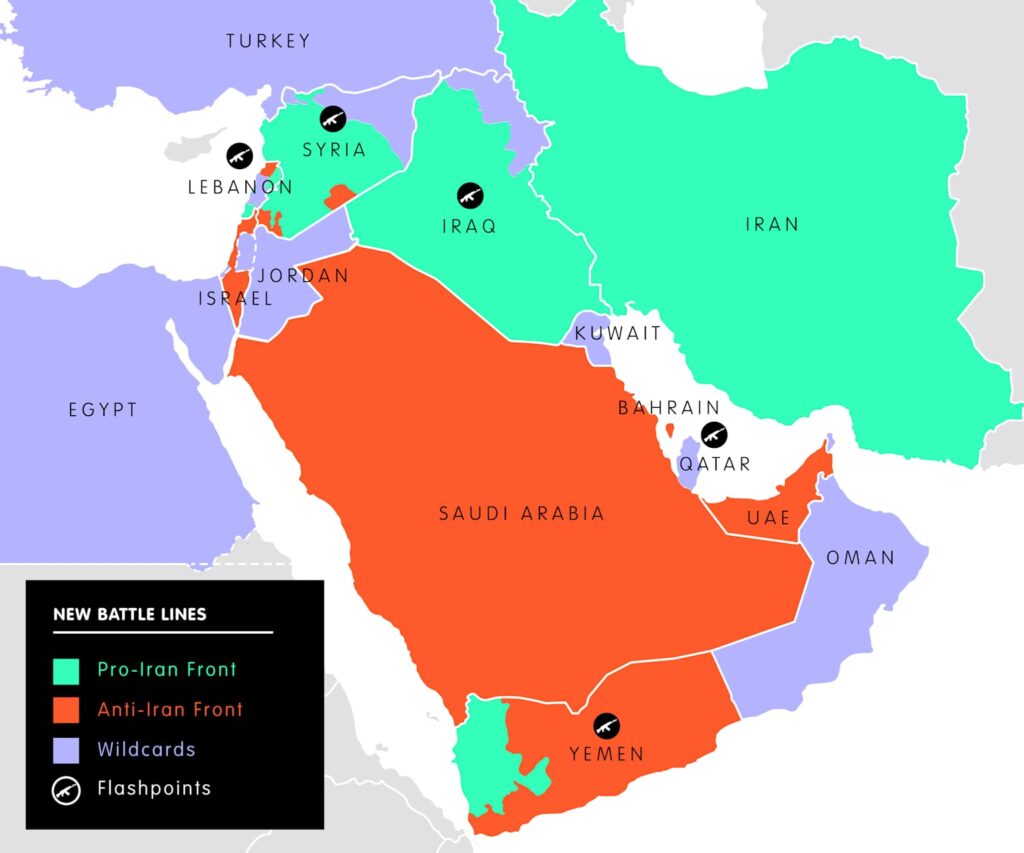
Core drivers and motivations for each side
Iran’s strategic perspective and regional ambitions
Iran’s approach to the conflict stems from multiple intersecting motivations, beginning with ideological commitment to Palestinian liberation and broader anti-Zionist principles that form core tenets of the Islamic Republic’s identity. The regime views support for Palestinian groups and opposition to Israel as essential elements of its legitimacy, particularly among Shia populations and broader Muslim audiences across the region. This ideological framework serves both domestic political needs and Iran’s aspiration to leadership within the Islamic world, challenging traditional Sunni-dominated hierarchies.
Regional hegemony represents another crucial driver, as Iran seeks to establish itself as the dominant Middle Eastern power capable of challenging American, Israeli, and Saudi influence. The concept of the “Axis of Resistance” reflects Iran’s strategy of building a network of allied movements and states to project power beyond its borders whilst maintaining plausible deniability. Security considerations also play a vital role, as Iranian leaders perceive Israeli military capabilities and alignment with the United States as existential threats requiring counterbalancing through proxy forces and deterrent capabilities.
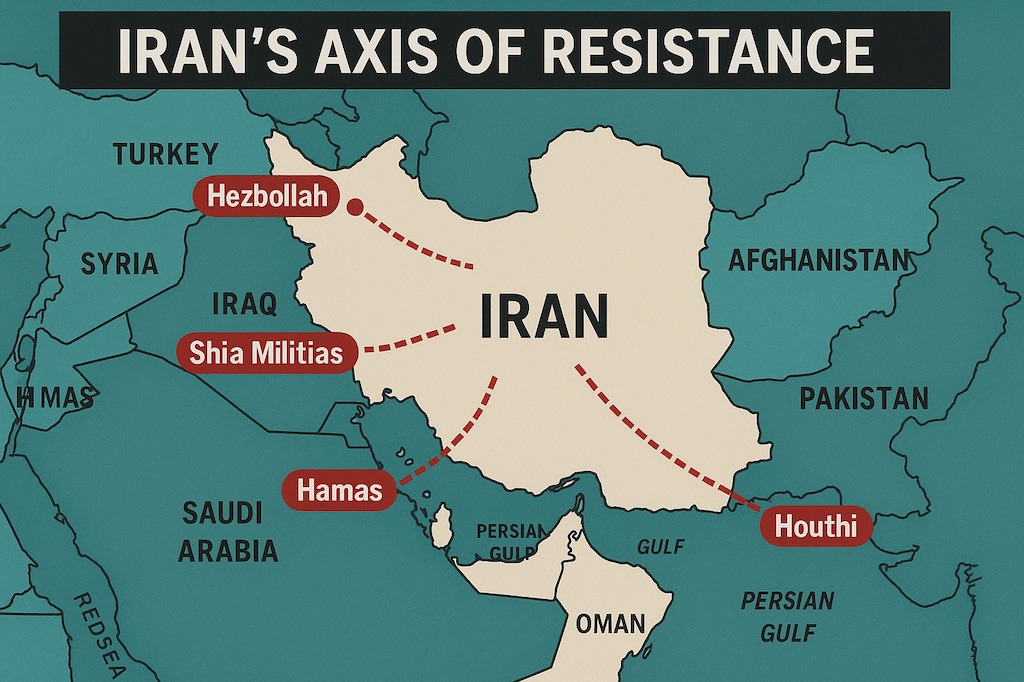
The recent escalation in June 2025 has intensified these motivations, with Iranian officials viewing Israeli strikes on nuclear facilities as crossing fundamental red lines. The elimination of senior IRGC commanders and nuclear scientists has created additional pressure on the regime to demonstrate strength and retaliate decisively.
Israel’s security calculus and existential concerns
Israel’s perspective on Iran centres fundamentally on existential security concerns, particularly regarding Iran’s nuclear programme and ballistic missile capabilities that could potentially threaten Israel’s survival. Israeli policymakers view Iran’s nuclear ambitions as crossing critical red lines, justifying preemptive action to prevent the emergence of a nuclear-armed adversary committed to Israel’s destruction. The concept of preventing a “nuclear Iran” has become central to Israeli strategic thinking, influencing everything from military planning to diplomatic initiatives.
Containing Iranian regional influence represents another core Israeli objective, as Tehran’s proxy network threatens to encircle Israel with hostile forces capable of sustained asymmetric warfare. Israeli strategic doctrine emphasises preventing Iranian entrenchment in Syria, disrupting weapons transfers to Hezbollah, and degrading the capabilities of Iranian proxies throughout the region. The perception of Iran as an expansionist power seeking regional dominance drives Israeli efforts to maintain military superiority and forge alliances with Arab states similarly concerned about Iranian ambitions.
The June 2025 strikes represent the culmination of Israeli concerns about Iran’s nuclear timeline, with Netanyahu claiming that Iran was approaching the technical capability to develop nuclear weapons within months. Israeli intelligence assessments suggested Iran possessed enough enriched uranium for nine nuclear weapons, creating what officials described as an unacceptable existential threat requiring immediate action.
Key arenas and manifestations of the conflict
The nuclear dimension: Iran’s programme and Israeli responses
The Iran nuclear program Israel dispute represents perhaps the most dangerous aspect of bilateral tensions, with Iran’s pursuit of nuclear capabilities fundamentally altering regional security dynamics. Iran’s nuclear programme began in 1957 with American assistance under the Shah, but expanded significantly after 1979, with the Islamic Republic establishing the Atomic Energy Organisation of Iran and announcing ambitious nuclear energy plans. International concerns intensified in 2002 when Iranian opposition groups revealed secret nuclear facilities, leading to decades of diplomatic efforts to constrain the programme through negotiations and sanctions.
Israel has consistently maintained that a nuclear-armed Iran represents an unacceptable threat, leading to various forms of sabotage, cyber attacks, and targeted assassinations of Iranian nuclear scientists. The Stuxnet cyber attack, widely attributed to Israeli-American cooperation, demonstrated sophisticated efforts to disrupt Iranian nuclear infrastructure without direct military confrontation. The June 2025 Israeli strikes represent unprecedented escalation, with Operation Rising Lion targeting the Natanz enrichment facility and killing two prominent nuclear scientists. The 2015 Joint Comprehensive Plan of Action temporarily reduced tensions by placing significant constraints on Iran’s nuclear activities in exchange for sanctions relief. However, the Trump administration’s withdrawal from the agreement in 2018 and reimposition of “maximum pressure” sanctions led to Iranian violations of nuclear restrictions and renewed escalation. Current negotiations remain stalled following the June 2025 strikes, with Iran reportedly possessing sufficient enriched uranium to potentially develop nuclear weapons within weeks if it chooses to do so.
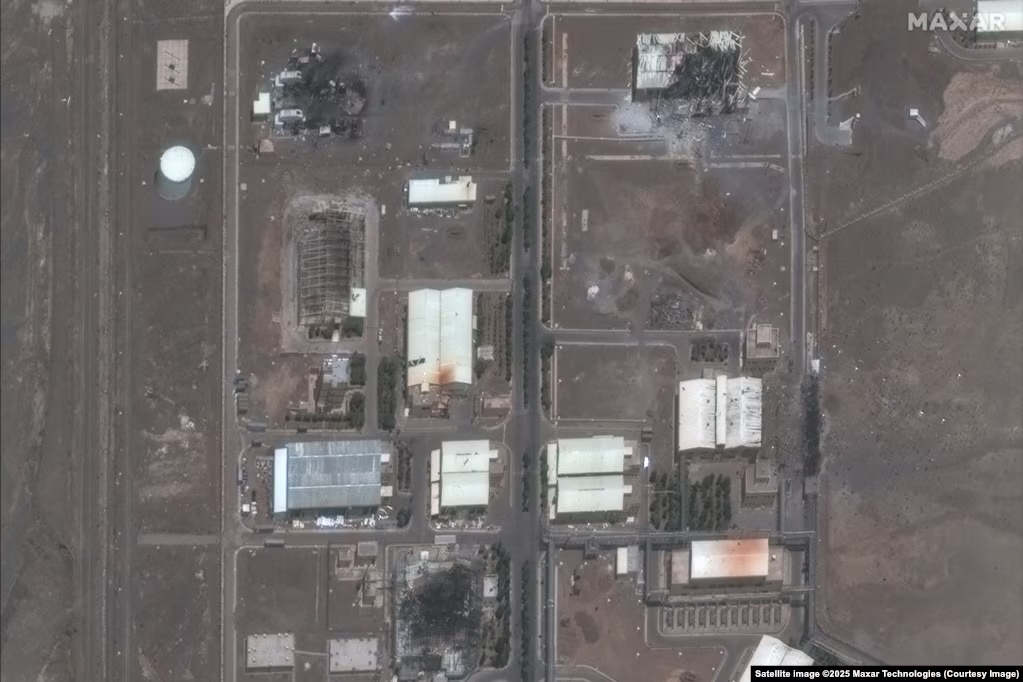
The proxy war network: Iran’s regional strategy
The Israel Iran proxy war manifests primarily through Iran’s extensive network of allied militias and movements across the Middle East, collectively known as the “Axis of Resistance.” Hezbollah Iran Israel dynamics represent the most significant proxy relationship, with Tehran providing approximately $700 million annually to the Lebanese organisation whilst maintaining extensive training and weapons transfer programmes. Hezbollah’s transformation from a small militia to a powerful force capable of challenging the Israeli military demonstrates the effectiveness of Iranian proxy strategy.
Iranian proxies Middle East extend far beyond Lebanon, encompassing Hamas and Palestinian Islamic Jihad in Gaza, Houthi rebels in Yemen, and various Shia militias in Iraq and Syria. Iran’s support for Hamas has intensified significantly, with annual funding reportedly increasing from $100 million to $350 million, enabling the group to develop sophisticated rocket capabilities and military infrastructure. The Gaza conflict Iran role became particularly evident during recent hostilities, with Iranian-supplied weapons and training contributing to Hamas’s military capabilities.
Read more: Israel Palestine conflict explained: a comprehensive historical analysis
Red Sea attacks Iran Israel tensions escalated through Houthi operations against commercial shipping following the Gaza war, demonstrating how proxy relationships can create global economic disruption. The Houthis’ campaign against vessels in the Red Sea has forced shipping companies to reroute around Africa, increasing costs and highlighting the vulnerability of critical maritime chokepoints. These attacks illustrate how regional conflicts can have worldwide implications through proxy relationships.
The recent Houthi announcement of a new “blockade” targeting vessels serving Israel’s Port of Haifa represents further escalation of proxy warfare tactics. This remote blockade strategy demonstrates how Iranian allies can project power far beyond their geographical boundaries whilst maintaining plausible deniability for Tehran.
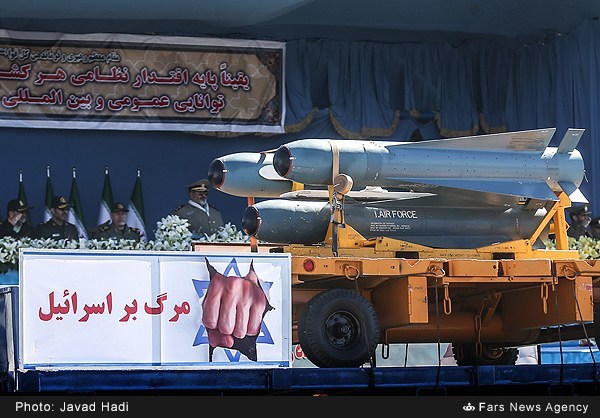
Cyber warfare and intelligence operations
The conflict increasingly features sophisticated cyber operations, with both sides engaging in attacks on critical infrastructure, nuclear facilities, and military systems. Israeli cyber capabilities have reportedly targeted Iranian nuclear facilities, oil infrastructure, and government systems, whilst Iran has responded with attacks on Israeli water systems, power grids, and financial institutions. The intelligence war encompasses assassinations of key figures, with Israel targeting Iranian nuclear scientists and military commanders whilst Iran attempts to strike Israeli and Jewish targets globally.
The June 2025 escalation included significant cyber warfare components, with Israeli forces reportedly conducting sophisticated sabotage missions targeting Iranian missile facilities and air defense systems alongside conventional airstrikes. This integrated approach demonstrates the evolution of modern warfare to include multiple domains simultaneously.
Key players and their roles
National leadership and military structures
The conflict involves key personalities whose decisions significantly influence bilateral dynamics, beginning with Iran’s Supreme Leader Ayatollah Ali Khamenei, who holds ultimate authority over nuclear policy and proxy relationships. Israeli Prime Minister Benjamin Netanyahu has emerged as a central figure advocating for aggressive action against Iran’s nuclear programme and regional expansion. Military organisations play crucial roles, with Iran’s Islamic Revolutionary Guard Corps and its Quds Force responsible for proxy relationships and extraterritorial operations.
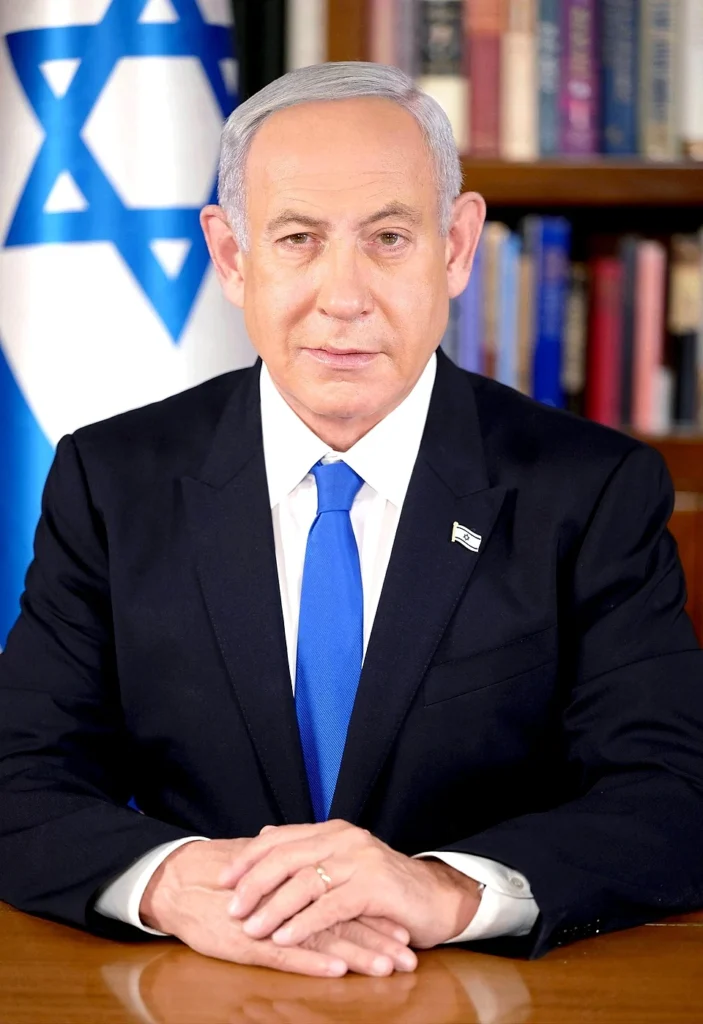
Israel’s response involves multiple agencies, including the Israel Defense Forces, Mossad intelligence service, and domestic security agencies coordinating comprehensive strategies against Iranian threats. The June 2025 strikes reportedly eliminated senior Iranian military figures including IRGC chief Hossein Salami and Chief of Staff Mohammad Bagheri, demonstrating the conflict’s intensification. These leadership changes could significantly affect future Iranian capabilities and strategic calculations.
International stakeholders and regional powers
The Middle East power struggle involves numerous international actors whose policies significantly influence conflict dynamics. The United States represents Israel’s primary ally, providing military aid, intelligence sharing, and diplomatic support whilst simultaneously imposing sanctions on Iran and attempting to constrain its nuclear programme. American policy shifts, including withdrawal from the JCPOA and varying levels of support for Israeli operations, directly affect regional stability.
Russia and China maintain complex relationships with Iran, providing economic lifelines through energy purchases and technology transfers that help Tehran circumvent Western sanctions. China’s Foreign Minister Wang Yi condemned the June 2025 Israeli strikes, calling for diplomatic restraint and warning of regional consequences. These relationships complicate international efforts to pressure Iran whilst providing alternatives to Western markets and technologies.
Regional Arab states have increasingly aligned with Israel against Iranian expansion, leading to Abraham Accords normalisation agreements and enhanced security cooperation. The Abraham Accords have largely survived recent escalations, though their future expansion remains uncertain given current tensions. Saudi Arabia and the United Arab Emirates view Iranian influence as threatening their interests, creating opportunities for Israeli-Arab coordination against common threats.
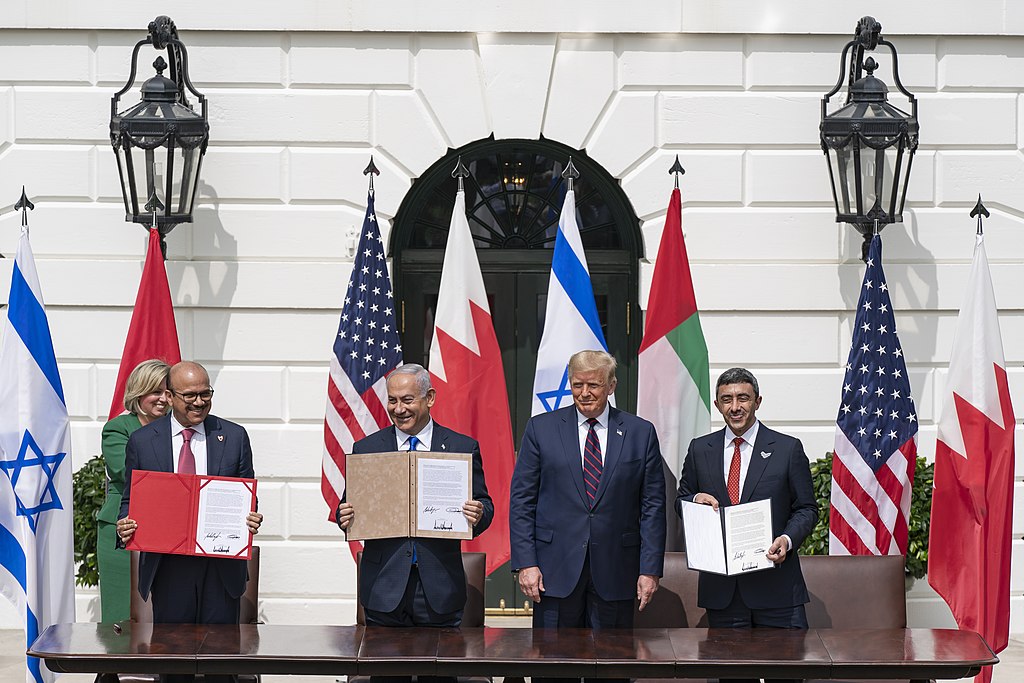
Impact and consequences
Regional destabilisation and humanitarian costs
The impact of Iran Israel tensions extends far beyond bilateral relations, contributing to widespread regional instability through proxy conflicts, arms races, and humanitarian crises. Syrian civil war dynamics demonstrate how Iranian support for the Assad regime and Israeli efforts to prevent Iranian entrenchment create sustained violence affecting millions of civilians. Yemen’s devastating conflict similarly reflects broader Iranian-Saudi-Israeli competition, with humanitarian consequences including famine, disease, and massive displacement.
Lebanon faces particular challenges as the primary arena for Hezbollah operations, with the organisation’s growing capabilities threatening to drag the country into wider conflicts. Palestinian territories experience intensified violence as Iranian support enables more sophisticated attacks whilst Israeli responses create cycles of retaliation affecting civilian populations. Regional arms races accelerate as countries seek to balance Iranian proxy capabilities and Israeli military advantages.
The June 2025 escalation has created immediate humanitarian concerns, with civilian casualties reported in both Iranian and Israeli strikes. The targeting of residential areas in Tehran and Tel Aviv represents a dangerous expansion of the conflict beyond military targets.
Global economic implications
The conflict significantly affects global energy markets through threats to critical chokepoints including the Strait of Hormuz and Red Sea shipping lanes. Iranian threats to close the Strait of Hormuz, through which approximately 20% of global oil supplies transit, could trigger worldwide energy crises and economic disruption. Recent Houthi attacks on Red Sea shipping demonstrate how proxy relationships can create global supply chain disruptions, forcing companies to use longer and more expensive routes around Africa. Oil price volatility reflects market concerns about potential escalation, with the June 2025 Israeli strikes causing immediate price increases of over 7% and renewed attention to energy security. Economic sanctions on Iran have reduced global oil supplies whilst creating opportunities for other producers, but also contributing to higher energy costs worldwide. The interconnected nature of global markets means that Middle Eastern tensions can affect inflation, economic growth, and financial stability far beyond the region.
Goldman Sachs analysts project that sustained conflict could push oil prices above $90 per barrel if Iran retaliates against regional energy infrastructure. American consumers face gasoline price increases of 10-25 cents per gallon in the coming weeks, representing a significant burden for families already grappling with inflation.
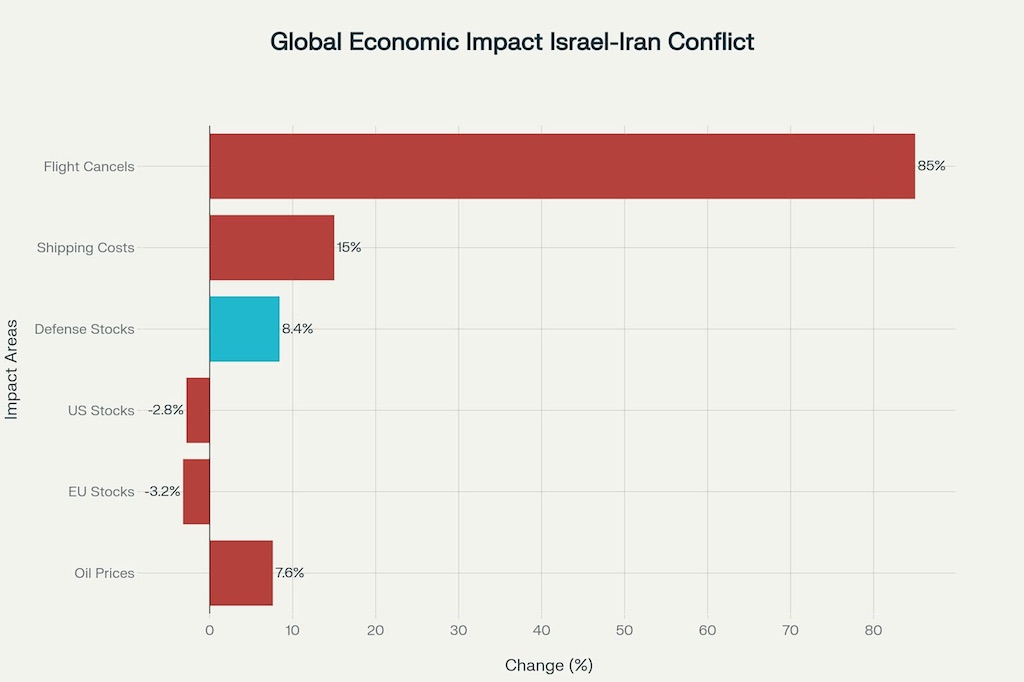
Nuclear proliferation risks
Perhaps the most serious long-term consequence involves potential nuclear proliferation throughout the Middle East, as other regional powers may seek nuclear capabilities to balance Iranian advances. If Iran develops nuclear weapons, Saudi Arabia, Turkey, and Egypt might pursue similar programmes, creating a regional nuclear arms race with catastrophic implications. Israeli threats of military action against Iranian nuclear facilities raise risks of broader conflicts that could destabilise the entire region.
International nonproliferation regimes face severe challenges if Iran withdraws from the Nuclear Non-Proliferation Treaty or achieves nuclear weapons capability, potentially encouraging other nations to abandon existing commitments. The failure of diplomatic efforts to resolve Iranian nuclear issues could undermine international law and institutions designed to prevent weapons proliferation.
How the conflict affects you: Personal and economic consequences
The Israel-Iran escalation extends far beyond Middle Eastern borders, creating tangible impacts on daily life for millions of people worldwide through energy costs, supply chain disruptions, and financial market volatility.
At the petrol station
Oil prices surged over 7% immediately following the Israeli strikes, with Brent crude reaching $78.50 per barrel—its highest level since January 2025. Goldman Sachs analysts project that sustained conflict could push oil prices above $90 per barrel if Iran retaliates against regional energy infrastructure or attempts to blockade the Strait of Hormuz, through which 20% of global oil supplies transit.
American consumers face gasoline price increases of 10-25 cents per gallon in the coming weeks, according to GasBuddy analysts. This represents a significant burden for families already grappling with inflation, particularly as the summer driving season approaches. Patrick De Haan, head of petroleum analysis at GasBuddy, warned that “Iran’s characterisation of the strikes as a declaration of war does not bode well for oil supply.”
In your investment portfolio
Global stock markets experienced immediate turmoil, with US and European indices plunging while defense contractor shares surged. The conflict has triggered a “flight to safety” phenomenon, with investors moving capital into US dollar-denominated assets and government bonds. Cryptocurrency markets also reflected the uncertainty, with Bitcoin showing volatility patterns similar to previous geopolitical crises. Frontier and standalone markets experience the most adverse effects, followed by developed and emerging markets, whilst pan-American stock markets show more pronounced effects than European or Asia-Pacific markets. The USD currency pairs exhibit positive abnormal returns suggesting flight to safety behaviour among global investors.
At the supermarket and beyond
The conflict’s impact on global supply chains extends beyond energy. The Red Sea crisis, exacerbated by Iranian-backed Houthi attacks on shipping, has forced hundreds of commercial vessels to reroute around Africa, adding weeks to journey times and increasing costs for consumer goods. The Houthis have announced a new “blockade” targeting vessels serving Israel’s Port of Haifa, further complicating international trade routes.
European leaders warn that prolonged Middle East conflict could trigger resurgence of inflation across Europe and potentially add “a stagflationary element to the eurozone outlook” where high inflation and weak growth become entrenched. Airlines have suspended flights to Tel Aviv, Tehran, and other regional destinations, while insurance costs for regional travel have spiked.
Future outlook and potential scenarios
Escalation risks and military confrontation
The future of Israel Iran conflict involves multiple potential scenarios ranging from continued shadow war to direct military confrontation with regional or global implications. The June 2025 Israeli strikes represent unprecedented escalation that could trigger sustained military exchanges if Iran chooses comprehensive retaliation. Military experts warn that miscalculation or accidents could rapidly escalate limited conflicts into broader wars involving multiple regional actors and potentially global powers.
Direct Israeli-Iranian warfare could involve ballistic missile exchanges, cyber attacks on critical infrastructure, and proxy mobilisation throughout the region. Iran’s weakened proxy network following Israeli operations against Hezbollah and Hamas may limit Tehran’s response options whilst potentially encouraging more desperate measures. The possibility of Iranian withdrawal from international agreements or acceleration of nuclear weapons development represents perhaps the most dangerous escalation scenario.
Netanyahu has declared that military operations will continue “for as many days as it takes” to eliminate the Iranian nuclear threat, whilst Iran warns of “more intense and powerful retaliation” if attacks persist. This suggests both sides remain committed to escalatory paths that could lead to sustained regional conflict.
De-escalation possibilities and diplomatic solutions
Despite current tensions, diplomatic pathways remain possible through renewed nuclear negotiations, regional dialogue mechanisms, and international mediation efforts. Changes in Iranian domestic politics following recent protests and economic pressures could create opportunities for more moderate policies and diplomatic engagement. Similarly, Israeli political developments and American policy shifts might enable new approaches to regional security challenges.
Regional initiatives involving Arab states, European nations, and other international actors could provide frameworks for reducing tensions and addressing underlying security concerns. Economic incentives, including sanctions relief and investment opportunities, might encourage Iranian cooperation whilst security guarantees could address Israeli concerns about existential threats. The success of such initiatives would require sustained international commitment and willingness by both sides to accept compromises.
Chinese Foreign Minister Wang Yi has emphasised that “diplomatic means to solve the Iranian nuclear issue are not yet exhausted and that hope for a peaceful solution remains.” However, Iran’s withdrawal from nuclear negotiations following the June strikes has significantly complicated diplomatic efforts.
Technological and strategic developments
Future conflict dynamics will increasingly involve emerging technologies including artificial intelligence, autonomous weapons systems, and advanced cyber capabilities that could alter traditional military balances. Iranian development of more sophisticated missiles and drones, combined with Israeli advances in defence systems and offensive capabilities, may create new forms of deterrence or instability. Regional militarisation through arms purchases and domestic production capabilities will affect conflict calculations and international security concerns.
Space-based assets, quantum computing applications, and biotechnology developments represent emerging domains for competition that extend beyond traditional military spheres. Climate change impacts on water resources, agricultural productivity, and population movements may create additional sources of regional tension requiring international cooperation. These technological and environmental factors will shape future conflict patterns in ways that current analyses may not fully anticipate.
Conclusion: A persistent challenge
The Israel Iran conflict explained reveals a multidimensional struggle that transcends simple bilateral rivalry to encompass broader questions of regional order, nuclear proliferation, and global security architecture. This analysis demonstrates how historical grievances, ideological differences, and strategic competitions have created seemingly intractable tensions with implications extending far beyond the Middle East. The evolution from Cold War partnership to contemporary hostility illustrates how regional dynamics can shift dramatically whilst creating enduring patterns of conflict and competition.
The June 2025 escalation marks a potential turning point that could either lead to comprehensive regional war or create new opportunities for diplomatic resolution. Current developments suggest that traditional approaches to managing bilateral tensions may prove insufficient given the complexity of proxy relationships, nuclear concerns, and broader geopolitical changes affecting the region. The interconnected nature of modern conflicts means that Israel-Iran tensions cannot be resolved in isolation but require comprehensive approaches addressing regional security architecture, international law, and global governance challenges.
Whether you’re filling up your car with petrol, checking your investment portfolio, or planning international travel, this conflict now touches your daily life in ways that seemed impossible just months ago. The persistence of this conflict reflects broader patterns in international relations where competing visions of regional order, technological capabilities, and alliance structures create sustained tensions requiring continuous management and innovative diplomatic solutions. Understanding these dynamics remains essential for policymakers, analysts, and citizens seeking to comprehend one of the most consequential geopolitical challenges of the contemporary era.
What’s next? Key scenarios and implications
Scenario 1: Escalation to regional war
- Iran targets Israeli cities with long-range missiles
- Israel expands strikes to Iranian oil infrastructure
- Strait of Hormuz potentially blocked, oil prices reach $100+
- US military intervention becomes likely
Scenario 2: Controlled de-escalation
- International pressure leads to ceasefire
- New nuclear negotiations with enhanced monitoring
- Gradual return to proxy warfare patterns
- Oil prices stabilise in $70-80 range
Scenario 3: Nuclear breakout
- Iran withdraws from Non-Proliferation Treaty
- Accelerated uranium enrichment to weapons-grade
- Regional nuclear arms race begins
- Global security architecture fundamentally altered
What to watch:
- Iranian Supreme Leader’s next public statements
- US military deployments to the region
- Oil futures markets and shipping insurance rates
- International diplomatic initiatives and mediation efforts
The next few weeks will likely determine whether this escalation represents a temporary spike in an ongoing shadow war or the beginning of a fundamental transformation in Middle Eastern security dynamics. For global audiences, the stakes couldn’t be higher—both for regional stability and the everyday economic realities that connect this distant conflict to kitchen tables worldwide.


